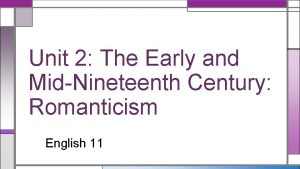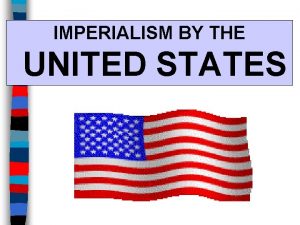Romanticism c 1790 1830 Victorian 19 th Century

- Slides: 1

Romanticism c. 1790 - 1830 • • • Victorian + 19 th Century c. 1830 1901 • • During the Elizabethan and Jacobean eras (1558 – 1625), Shakespeare dominates the literary headlines. Marlowe, Kydd and Donne were also prominent during this period. The later parts of this era, when Oliver Cromwell establishes a Puritan dictatorship after removing the monarch of the time (Charles I), sees the emergence of John Milton and his most celebrated work Paradise Lost. The Romantic era (c. 1790 – 1830) is famed for its poetry, dealing with themes of imagination and individuality, especially with regards to theme of nature. Coleridge, Blake, Keats and Shelley all wrote about these themes across the period. Spanning both this era and that of the reign of Queen Victoria were the Gothic writers. Bram Stoker’s Dracula, Mary Shelley’s Frankenstein, as well as the works of Edgar-Allan Poe and Hawthorne, are some of the most well known Gothic stories. Drawing influence from Gothic literature, many other writers rose to prominence in the 19 th century. Elizabeth and Robert Browning, Tennyson, the Bronte sisters and Charles Dickens all feature heavily throughout the era, dealing with wide ranging themes including poverty, religion and industrialisation. Literary Conventions of the Era Key Vocabulary and Definitions • Plays, as one of the central forms of entertainment, account for a lot of the most popular literature in this era. Shakespeare is of course the most well known and influential of the playwrights in this era, dealing with his three central genres: comedy, tragedy and history. There are many similarities between his plays and those found in the Classical era. Renaissance: Revival or renewed interest. Social activism: Engaging in activities designed to increase awareness of an issue. Protest: Actively seeking to express an objection to an idea. Religious influence: The way that the ideas of a religion can influence the minds of the public. Industrial revolution: A period in of great technological advancement that led to the modernisation of several practical roles and the creation of factories. Gothic: A genre focussing on the supernatural and macabre. Known for the creation of tension through bleak, atmospheric settings. Romanticism: A literary movement centred around the ideas of inspiration and the importance of the individual. Motif: A recurring idea in literature. Context: The information surrounding a text, such as setting, time period, beliefs and significant events. Pathetic fallacy: The creation of mood through the presentation of the weather. Atmosphere: The mood/tone established, usually through description of the setting or the senses. Pathos: A quality that creates pity or sympathy for a character Structure: The way a text is set out by the author. Form: The designed shape/style of a text, especially relevant in poetry. Conventions: Themes/ideas/literary techniques you expect to see in a particular genre/form. • Poetry is one of the key elements of literature in this era. Romanticism changes the face of poetry – epics are much rarer. Instead, poetry becomes more a vessel for symbolism and imagery, rather than being driven by narrative. Many Romantic ideas continue into Victorian literature. • Gothic literature is the most popular literature of the era, with the Victorian fascination with the supernatural and macabre used to great effect by the authors of the time. Scientific, technological and industrial advancements gave authors licence to exploit the public’s unfamiliarity with these developments as a way to stimulate their appetite for the supernatural. • Many Victorian novels play on these gothic aspects, but they also became vehicle for social change. Literature becomes much more progressive and popularised as the standard of education improves. Historical Context 1439 – 55: The Gutenberg press is invented, revolutionising the way literature is reproduced and leading the printing of the Gutenberg Bible. 1604: Robert Cawdrey’s Table Alphabeticall becomes the first single language English dictionary published. 1712: Thomas Newcomen creates the first steam engine 1811: The first Luddite riot took place in Nottinghamshire, where the destruction of machines led to a change in laws around the destruction of machinery in 1812. 1837: Queen Victoria takes the throne 1838: Slavery abolished in the British empire 1880: Schooling for 5 -10 year olds becomes compulsory. Year 8 Literature Through the Ages Knowledge Organiser Renaissance + Reformation c. 1485 -1660 CE Literature Timeline

